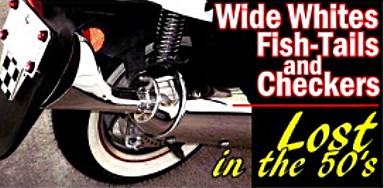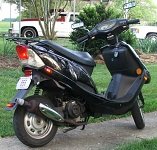|
|
Post by oldchopperguy on Jul 12, 2013 23:45:42 GMT -5
Did you have that exhaust on the bike before modifying it? I have the same(well, really similar) exhaust on my scooter. Came new that way, and it's a four stroke. Im going to use it as is on a new modified engine,and I'm just wondering how yours performed before mods. Was it acceptable? or downright no good? That was five years ago. It took a full year to get it "right". My carb NEVER would work right with ANY extension of ANY kind on the mouth... (ESPECIALLY THE FACTORY SYSTEM)... not even a rubber extension for a performance filter, WITH NO AIR-FILTER attached. I finally got the carb right, using a UNI "sock" filter. That fixed the carb problem. My engine will ONLY run right with either NO filter (not acceptable... LOL!) or the UNI with NO extension. This is rare, but other riders have reported similar complaints. That little annoyance has GOT to be partially responsible for the numerous reversed-carbs seen today. I'm seriously considering that option myself, to make air-filter experimentation "a piece of cake".The engine never would rev, and a common eBay no-rev-limit CDI fixed that (some). Adding a Bando coil and Iridium plug fixed it better. Now the engine would pull well from idle to over 9,000 rpm, but even with needle adjusting, and all sorts of tuning, it always had a very slight "bog" in throttle response, and very minor "erratic" running at times. Minor flaws I lived with, but still not quite perfect. So, the mods made BEFORE the new pipe were: 1. UNI air-filter. 2. No-limit CDI. 3. Bando coil. 4. Iridium plug. 5. METICULOUS carb adjusting, especially the needle. 6. Adding a cooling-fan-scoop.After installing the new exhaust, with NO carb adjustments, all bog was gone, with snappy acceleration from idle to WOT. Erratic running ended. I attribute this most likely to the larger-diameter header "unstopping" the bottleneck at the head/header junction, with the resulting scavenging and cooler head-temperature. Please note also: My engine-oil temperature was reduced SIGNIFICANTLY and I honestly can't be sure if that is due to the heat-wrapping on the header, or, the extended fan-scoop, or both. Also note: With the stock exhaust, and my carefully-tuned carb, the plug showed a perfect tan/brown condition. With the new exhaust, the plug is reading a little on the sooty-rich side (the OPPOSITE of the lean condition I'd expect). Since slightly rich runs cooler, and the engine is performing PERFECTLY... I'm going to leave it as-is for now. If it costs a few mpg, and I need a new plug each season, I can live with that for the great performance I'm getting. Even on a 4-stroke, these expansion-chambers can draw a slightly increased fuel-charge into the combustion-chamber if the valve timing is condusive to it. Since your scooter has this type of system, it is probably designed from the factory to run with it. That shows some better-than-typical Chinese engineering... I'll bet the farm that your carb is easier to adjust than most, also. I know this is a little long, but hopefully it will give you a better overview concerning my own lengthy experience before, and after the exhaust mod. I believe I had the engine running as good as possible with the stock exhaust, and, now it runs even better. These scoots are all different, and what works on one may not work on another, but anything that works once is worth a second try...Sincerely, Leo in Texas PS: Since this seems to be my "season" of correcting "things Chinese" I'll add the fact that I'm also doing my best "tweaking" of the CVT tranny. I installed a Prodigy variator, and have done all the experimentation with roller weights I care to... I found 13-grams too heavy, killing acceleration, but giving a 55 mph top-speed. 12-grams were too light, giving good acceleration, but only 45 mph top-speed. I currently have a mix of 3 12's and 3 13's installed, giving strong acceleration, and a 53 mph top-speed. This seems to be the best compromise with ROLLERS. At Alleyoop's recommendation, I'm going to try 13-gram SLIDERS. I do believe sliders offer some advantages over rollers, giving BOTH quicker acceleration, AND higher top-speed. We shall see... I'll post when I get them in and tested... Right now, I'm enjoying the best performance I've had in five seasons... LOL! |
|
|
|
Post by prodigit on Jul 13, 2013 0:25:51 GMT -5
It would be interesting to know if you could plug in a stock pipe, see how it performs as is with a stock pipe, and then just hone down the smalled diameter pipe to be ~1in at the mounts, to 7/8" on the pipe, kind of create a funnel, like in image below; and see how that compares to a 1" diameter pipe!  |
|
|
|
Post by scootnwinn on Jul 13, 2013 0:31:26 GMT -5
People do that all the time it's called porting. It works. Not necessarily as well as a larger pipe but depending on the application it might be exactly what is needed...
|
|
|
|
Post by oldchopperguy on Jul 13, 2013 0:36:05 GMT -5
know that there is more heat transfer to the engine from metallic contact, than through air! But this 1 1/8" O.D. pipe comes TOO close to the block for comfort... So close that any unwanted movement, or expansion WILL bring metallic contact... I probably could get away with the plain pipe, but... "Just playing it safe".Ideally I'd like to have run the header UNDER the frame. That would solve everything, and would have kept everything cool and simple. But... that also makes the header the LOWEST part of the scooter. It would be the first thing to hit speed-bumps, etc. and wrench the cylinder & head right off the crankcase... At first I wondered, and, now I understand why the Chinese stuff the header between the frame and the block! I truly wish the designers would have raised the engine just one-inch higher in the frame... How much simpler it would be to fabricate a proper header... Even at the factory! Oh well, that's what modding these scoots is all about... LOL!Leo |
|
|
|
Post by scootnwinn on Jul 13, 2013 0:39:31 GMT -5
Since the metallic contact is static and unchangeable the only thing you can do is hope to limit transfer by air. I doubt the increase in metal temp caused by wrapping it is extreme...
|
|
|
|
Post by oldchopperguy on Jul 13, 2013 0:41:55 GMT -5
It would be interesting to know if you could plug in a stock pipe, see how it performs as is with a stock pipe, and then just hone down the smalled diameter pipe to be ~1in at the mounts, to 7/8" on the pipe, kind of create a funnel, like in image below; and see how that compares to a 1" diameter pipe!  It would certainly be my choice if I wanted to keep a standard muffler connection and mount. Just off hand, I'd think this beveling of the header flange should provide at least 75% as much improvement as the full-diameter header. It's certainly an easier and less-expensive mod, and worth a try. If you could connect it up with a 1" (or LARGER) PIPE a few inches "downstream" it might even provide the "reverse venturi-style" scavenging like the expansion-chamber exhausts, with most any decent muffler. Leo |
|
|
|
Post by prodigit on Jul 13, 2013 2:23:32 GMT -5
Right, I forgot the pipe has a gasket inbetween that insulates the heat too!  Perhaps try putting a thicker gasket might help too?  There's also heat transfer from the pipe through the bolts/nuts into the engine block, but that should be minor. I believe the fan scoop is responsible for most of the drop in heat in the oil. I personally wouldn't put it on a 50cc 4 stroke, but perhaps on a 2 stroke or a 150cc or up it might prove handy, as usually under 35MPH those scoops don't provide a lot of cooling. On the other hand, cooling down the engine this much, makes it lower performing. Most of the time my scooters perform between 5 to 10% better when they're hot (riding WOT for at least 15-20 minutes), than when they're cold. |
|
|
|
Post by sailracer on Jul 13, 2013 2:45:22 GMT -5
Thanks Leo,
The reason I asked is because I prefer to use this system with the expansion chamber, but I am concerned it won't handle the 50mm BBK & cam I put in the new motor. actually, I'm a bit reluctant to put the new motor in as the factory motor, with a koso variator & sliders is running beautifully. Only complaint is hillclimbing really. But the variator mod improved that too. The motor I built has A 50mm BBK, 50mm head, a9 cam 20mm carb, I got a couple of extra jets (larger),iridium plug,orange coil, The variator (which i put on existing motor) and 50/16 gears.I would like to use the stock airbox & exhaust. (drill airbox if needed) I like the idea of porting the header.
|
|
|
|
Post by prodigit on Jul 13, 2013 7:34:13 GMT -5
I wonder if using a bigger exhaust pipe actually causes worse gas mileage?
|
|
|
|
Post by ltdhpp on Jul 13, 2013 11:13:33 GMT -5
I know this is a little long, but hopefully it will give you a better overview concerning my own lengthy experience before, and after the exhaust mod. I believe I had the engine running as good as possible with the stock exhaust, and, now it runs even better. These scoots are all different, and what works on one may not work on another, but anything that works once is worth a second try...I had a similar experience - and strongly agree with meticulous needle tuning. It wasn't until I started messing with the needle that I got the most out of my mods, even before the pipe. I did wind up up-jetting after the pipe, from a 108 to a 114, and holy smokes! It was a whole new animal. Only thing different was when I tried almost every roller/slider mass between 8g and 12g, and never lost any top speed. 8g sliders gave me wicked acceleration, top speed was still 60ish but RPMs were WAY too high at top speed. 10g sliders left me sad, so I settled for 9g equivalent. Of course, between my larger frame and my larger self, I'm permanently riding 2-up compared to most other 150's, and I live in the 'Hill City'... |
|
|
|
Post by oldchopperguy on Jul 13, 2013 11:45:15 GMT -5
Itdhpp,
Welcome aboard, and thanks for the comments! For a scooter design that's so universal, I've never seen such variety in how the same mods will affect each individual scoot...
I actually had to lathe-turn a couple of extra notches in my own needle to get enough adjustment! And, weight MUST make a big difference. I weigh 235 so I outweigh my scooter by a few pounds... I also ride 2-up sometimes, and that is asking a LOT from a scooter... LOL!
With some of these, I believe the only way to get the highest top-speed is to change the final gears. And on some mostly-stock engines, they still won't have the torque to handle any taller gearing. We all like the super-low cost and simplicity of the 150 air-cooled scooters, then often spend hundreds of dollars, and MANY hours trying to get them to run highway-speeds, which they weren't really meant to do. I do wish the Chinese generic GY6's came in a true 175 or 200cc version. They're just maybe ONE or TWO horsepower, and a couple of foot-pounds of torque short of being the ideal all-purpose ride.
They come SO close, and JUST miss the mark by a few mph... Then we borrow a pal's Vespa 150 on its itty-bitty wheels, mini-bike size frame, and zip right down the road at 70 mph like we were on a full-size cycle... Cheesh! It absolutely CANNOT take THOUSANDS of dollars, and Italian craftsmanship to get a scooter to run like a "big-bike"... or can it? Maybe it does...
Ride safe,
Leo in Texas
|
|
|
|
Post by oldchopperguy on Jul 13, 2013 12:08:45 GMT -5
Thanks Leo, The reason I asked is because I prefer to use this system with the expansion chamber, but I am concerned it won't handle the 50mm BBK & cam I put in the new motor. actually, I'm a bit reluctant to put the new motor in as the factory motor, with a koso variator & sliders is running beautifully. Only complaint is hillclimbing really. But the variator mod improved that too. The motor I built has A 50mm BBK, 50mm head, a9 cam 20mm carb, I got a couple of extra jets (larger),iridium plug,orange coil, The variator (which i put on existing motor) and 50/16 gears.I would like to use the stock airbox & exhaust. (drill airbox if needed) I like the idea of porting the header.
I tend to agree that if you have a really good runner, it seems a shame to change that motor. I think the expansion-chamber would still be well-able to accommodate your hotter motor though. They have PLENTY of space in the chamber... With the right size header and tail-pipe, I think they'd run OK on a 1,000cc cycle engine! While the chamber has to be spot-on perfect on a 2-stroke, and even then, it's perfect ONLY at the rpm it's tuned for... On a 4-stroke, the design is mighty forgiving... We raced 2-stroke go-karts and played with these pipes a lot in the sixties on 4-stroke "fun-project" 4-cycle engines (mostly flathead Briggs and Clintons) but also on Harleys and Brit cycles. We found a pair of chamber-pipes made for a 175cc McCulloch 25K rpm 2-stroke ran well enough on a Triumph 650 at any old rpm. The pipes are "rocket-science" on a built 2-stroke, but just a mild "improvement" and "quiet megaphone" on a 4-stroke... Still better I think, than a regular muffler though!Whatever option you go with, enjoy the ride!Leo |
|
Sophomore Rider
  
Currently Offline
Rear wheel drive
Posts: 207
Likes: 0
Joined: Mar 9, 2013 0:05:20 GMT -5
|
Post by justin010304 on Jul 13, 2013 14:51:30 GMT -5
They do make one, the b case 161qmk, it's a 170. I see a lot of talk about expansion chambers, but you think if it would work all the big names would be using them as well as automobile manufactures?
|
|
|
|
Post by prodigit on Jul 13, 2013 15:04:04 GMT -5
If you want to reduce exhaust heat from the pipe to the engine,
I've noted my ATM50 uses a regular gasket. Those gaskets insulate heat.
However I've seen metallic gaskets, and I've seen copper gaskets.
Those gaskets actually transfer more heat into the engine than the exhaust wrap is insulating the engine from.
Exhaust pipe may be hot, but most of the heat gets transferred via metallic gaskets, not via the air or radiation around the pipe.
Then there's another danger, in if you let the bike sit in rain, the wrap will soak up water, and keep the exhaust pipe wet for a longer time, causing it to rust faster.
|
|



















 jet
jet





